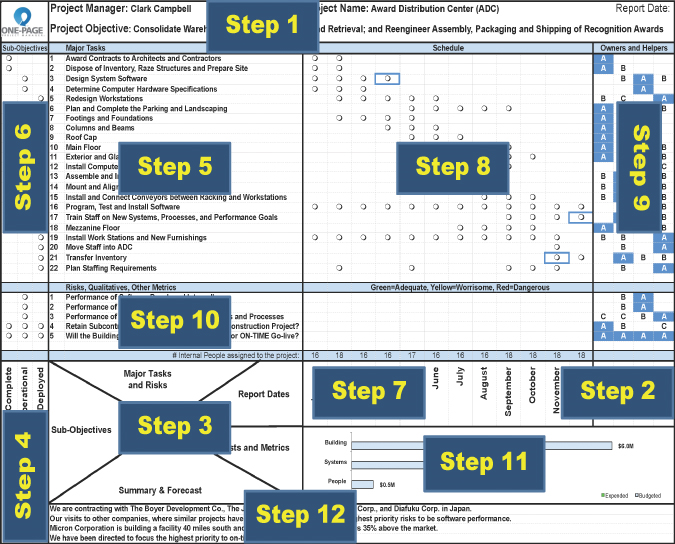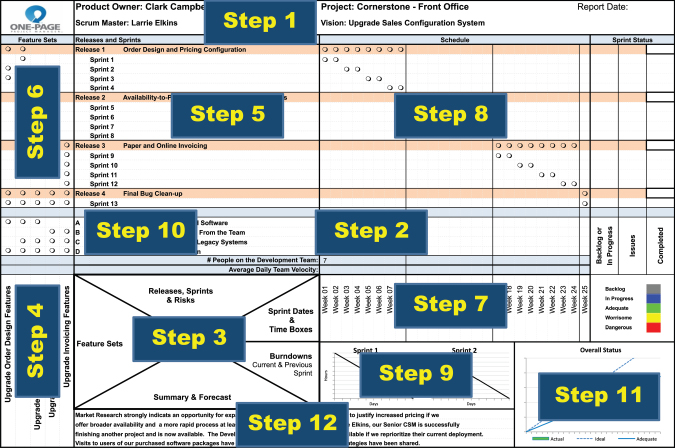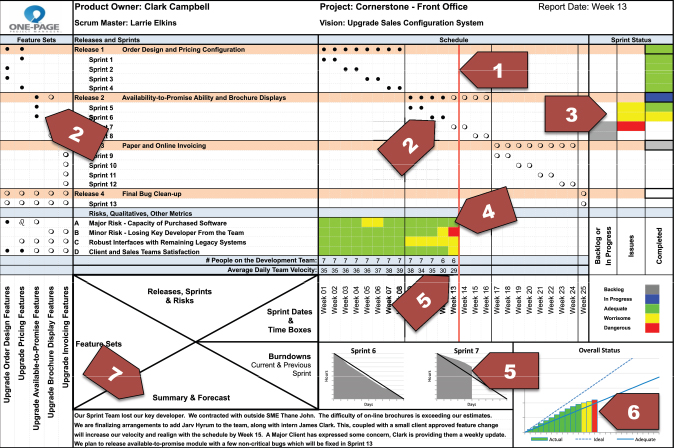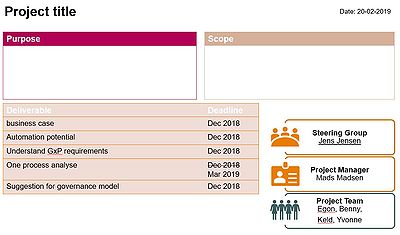Agile One Page Project Management
Written by: Thea Salomon Pedersen
Contents |
Abstract
In this article the Agile One Page Project Management will be described and reflected on. The article will start with a description on the One Page Project Management (OPPM), what it can be used for and why it’s good. It will be defined what the 5 different features behind the OPPM is. Afterwards the Agile Project Management will be described and a fit between the agile project management and OPPM will be made.
In the next section it will be described how the OPPM can be created in the 12 different step the agile OPPM consist of. It will also be described how the tool can be maintained in 7 different steps throughout the progress of the project. Furthermore, the pros and cons of the OPPM will described, and a similarity measurement for both PMBOK and PRINCE2 to the OPPM will be made. Lastly a discussion on how the OPPM is used in a pharmaceutical company, and another one-page tool will be described.
One Page Project Management

What is good project management? Some will say that good project management is when the project is done on time and on budget and has the ability to communicate project performance (scopes, timeliness and planned versus actual resources) and expectations to team members and stakeholders. To do a project well, a project manager is necessary. But the project manager cannot do everything on their own, he or she needs to have corporation from the team. To get the team onboard and understanding the project different aspect from the start different tools can be used. One of these tools is the; One Page Project Management (OPPM). OPPM is founded by Clark A. Campbell, he holds a BS in Chemical Engineering and MBA and a Ph.D. in Business Administration [2] . OPPM is a visualization tool on one single page (Figure 1). The OPPM helps the project manager communicate sufficiently to the team, so the project gets tangible for everyone. The OPPM is also an advantage when keeping different stakeholders informed, because the tool is easy to understand and because it can be maintained through the progress of the project.
The OPPM tool have 5 useful features;
- Use of the five essential parts of a project (tasks, objectives, timeline, cost and owners) plus risk and quality
- The linkages and alignment of each in statement 1.
- A clear, efficient and accurate description of both plan and performance
- A helping tool to the project manager rather than a replacement
- An intuitive graphic that is easy to use and maintain.
When looking at Figure 1 a traditionally OPPM is shown. This OPPM is divided into 12 different steps; which is the header, the Owners, the Matrix, the Project Sub-objectives, the Major Tasks, the aligning Tasks to Sub-objectives, the Report Dates, the Aligning Tasks to Report Dates, the Aligning Tasks and Schedule to Owners, the Risk, Qualitatives and Other Metrics, the Cost and Metrics and the Summary and Forecast. With these 12 steps a project manager can get a clear overview and give the team a clear overview of the project timeline, the scope, the different risk and the cost. So the idea is that you break down the project, so it fits into the different step of the OPPM. More generally speaking project is all about getting things done, so it shown results and a progress of the project and thereby successfully completing tasks. The OPPM also help on this matter, because both project manager, team members and stakeholder can see a progress in the project and thereby they tend to see the good an efficient part of the project, instead of the part with did not go that well. [1]
Agile Project Management
The OPPM can easily be aligned with the agile project management. The key concept behind the agile project management is that the work and responsibilities is divided into 3 different roles; the product owner, the Scrum Master and the team members. The product owner organizes and handles the goals, tradeoff of schedule and scope and adapting to change the project requirements and priorities. The Scrum Master knows the process, which gives the Scrum Master the ability to guide the team, so they know how to prioritize their tasks. The team member handles most of the tasks, progress reporting and make the quality control for the product.[3]. But it is also essentially to tell that both the product owner and the Scrum Master is acting as team members during the development of the project.
Another important and special feature of the agile project management is the different sprints which defines the project. Each sprint has a defined goal, which has to be reached, and the length of these is often between two to four weeks. After each sprint the team members, scrum master and product owner will meet to get an overview of how well the project goes along. [4]
Agile One Page Project Management

The Agile Project Management can easily be use together with the OPPM. By doing so instead of the Major tasks list, the agile OPPM will have a list of different sprints, within different releases.
The agile OPPM can be seen at Figure 2. In the agile OPPM there are 12 different steps which needs to be considered and initiated to get the best representation of the OPPM.
Step 1, The Header. Here the user needs to provide the name of the project, the product owner, the scrum master, the vision of the project and the report date, which is when the OPPM is made.
Step 2, Development Team. The Development Team step is where the team is made. The optimal size of a team is between five and nine people. It is important to notice that in the agile team the teams are often smaller and work closely together, compared with traditional project teams. The different team members need sufficient skills to accomplish the tasks.
Step 3, The Matrix. Here all the hub of the OPPM is made and all points meet. At this step the product owner will gather the scrum master and team members together to discuss how the project should be handled. In this step it is important for the product owner and the scrum master to get the team to master and fulfill agile product management.
Step 4 Feature Sets. Feature Sets finds the most important features which provides business value, together with the customer. In agile OPPM there will be many features and therefore it is recommended to group them into different umbrella groups with similarities, so they can fit the OPPM.
Step 5 Releases and Sprints. Releases and Sprints defines and planes the baseline of prioritization. The development hours are highly important to consider here. The product owner decides when the sprints are released. The product owner needs to make a hierarchy for the different sprints so they build iteratively on the previous one. In each release there can be 4-12 different sprints.
Step 6 Aligning Sprints with Feature Sets. Aligning Sprints with Feature Sets it a high-level planning result, that shows which features are going to be captured in each sprint. In agile is it central to plan, and to adjust the plan along the way.
Step 7 Sprint Dates and Time Boxes. Sprint Dates and Time Boxes, here the released and individually sprints are given a time period, which also mean that the hole project is given an end date.
Step 8 The Schedule. Here the releases and sprints are aligned with the time boxes. This gives the product owner, scrum master, team members and stakeholder a precise idea on how the project will go along.
Step 9 Backlog Burndown. Backlog Burndown is a graphical display of the development process for each spring, where the progress can be measured over time. The burndown chart shows the progress from the previously sprint and the current sprint. The burndown chart could also be shown for the release instead.
Step 10 Risk, Qualitatives and Other Metrics. Risk, Qualitatives and Other Metrics is a subjective or qualitative step of the project. Meaning, the features needs to align with different levels of risk. “A” is a major risk, “B” is a minor risk, “C” can be another more capturable risk and “D” is the client and sales teams’ satisfaction.
Step 11 Overall Status. Overall Status gives senior management and other stakeholder a status report on how the project is going. On the graph there are 2 lines, a solid and a dotted line. The solid line shows the adequate performance and is usually 10 percent under the expectation, while the dotted line shows the ideal progress and is normally 10 percent better than the expectation. So if the project is in between these two lines the performance of the project is as expected.
Step 12 Summary & Forecast. Summary & Forecast is the last step in filling out the agile OPPM. At this step the readers will be informed about the project status and what the future steps will be. As seen this step does not have much space, this is on purpose. The project can better and more accurately be described by a graphic instead of words.
Maintenance

One can now see on Figure 2 that is it nearly filled out. The rest of the boxes which is not filled out, is used to maintain the OPPM. More generally speaking there is seven reporting steps to maintain through the progress of the project (Figure 3).
Step 1, at arrow 1, one needs to place a vertical red line, here shown between week 13 and 14, to show the current time. When doing this the reader of the OPPM, gets a quick view on timeline. In step 1, one also needs to fill in the report date, which is placed in the upper right corner.
Step 2, at arrow 2, is where you fill out the dots. These dots explain how the different sprints are completed. As it can be seen from Figure 3, the team is finished with the first release and is ongoing with release 2. Release 3 hasn’t started yet, which can be seen from the unfilled, but also from the timeline, which state that release 3 will first start in week 17.
Step 3, at arrow 3, is how well it is going with the different sprints. At this step the OPPM uses colors to describe the improvement. If the box is green it means that the sprint was adequate, if the box is gray is means that the sprint is backlog, blue means that it is in progress, yellow means worrisome, which means there is an issue in the project, and red means dangerous. A closer look at Figure 3, at arrow 3, will also show the 3 different columns; a Backlog and in progress column, an Issues column and a completed column. With these 3 columns OPPM can more precisely define the process of the sprints. In the first release is can be seen that this was delivered in time and if we look at the sprints it can be seen that it was successful, and the customers were satisfied with the result.
Step 4, at arrow 4, also uses the color code, described in step 3. At this step the purpose is to maintain and handle the Risk, Qualitatives and Other Metrics on the time of the project. Meaning it follows the red line drawn in step 1.
Step 5, at arrows 5, here the top arrow describes the Average Daily Team Velocity, which means the work the team members can put in the project. The number is found by counting the number of units of work completed during a specified time period. In this step the OPPM also require the number of people on the development team, which at this current time is 6 people. The bottom arrow shows 2 graphs, the burndown chart, that indicate the previous sprint and the current sprint. The curve shown, day by day, the time spend and the time left of the sprint according to the work left.
Step 6, at arrow 6, once again uses the color codes described in step 3. At this step the OPPM describe the overall status of the project. Looking at the graph it can be seen from the green colors that the first 10 weeks was progressed at least adequately, week 11 and 12 are yellow which means that the project has had some issues, and week 13 is red, which indicates a period with severe struggles. The curves in the other hand shown that the project is in perfect condition, which is indicated by the bars being in between the two lines.
Step 7, at arrow 7, a written description of the summery and forecast is made. Here the purpose is to explain why things are happening and what will be done to improve the progress of the project.
Usefulness
The agile OPPM is best used in project with less complexity. This means that the project is straightforward, when you have projects that repeats, when a project has clear-cut steps and when the task is lack ambiguity. OPPM does not work that well on software projects, product revisions or long-term complex projects. [5] The reason it is not working very well on some types of projects is for instance that the OPPM is not that good when one has a lot of different tasks that needs to be tracked, then a task list will suit better. [6] The limited space is often one of the difficulties about one pagers.
As reflected upon earlier it can also be assessed that the OPPM will save time, because the product owner, scrum master and team save time, because a baseline on the different steps and concerns in the project is found and visualized from the start of the project. One of the big advantages with the OPPM is its perfect way to produce the project status report ongoing the project. When remembering this, it is also necessary to say that the tool is not a replacement of different tools a project manager is already familiar with, and there is nothing new about the OPPM. The essentials about this tool is how a project can be visualized in a good and simple way.
As already mentioned regarding the agile project management, the team and the communication around and between the team members is very important and necessary for this tool to work as intended. The OPPM is a team effect, which means that the team members consist as the task owners.
Similarity Measurement
When comparing the OPPM with the PMBOK it can be noticed, that OPPM does not have any new points in the project management phase. In the PMBOK the first step is to initializing the stakeholder [7], this step is not in the OPPM, but one must think that the product owner has his stakeholder on place before be planning and preparation of the OPPM. Another thing which is not required in the PMBOK is the business documents. [7] This documents are important and the product owner need as well to have this under control before starting on the OPPM.
In the PMBOK there is quite a lot of steps to consider when developing Project Management Plan. One needs to consider and perform Risk Management, Procurement Management, Communications Management, Resources Management, Scope Management, Schedule Management, Stakeholder Management, Cost Management and Quality Management. [7] In each of these steps there is a lot of work and time spent, but if one considers all these things one will have a perfect overview of the project. And if the project is complex one needs to consider and perform all these steps. But if the project is more straight forward, and with clear-cut the OPPM while save a lot of time and will give a clear overview of the whole project.
The OPPM is only an assistance tool, it does not mean that you don’t need to spend time on the different categories in the Project Management Plan from the PMBOK. The OPPM does not consider the stakeholder, the cost, quality or the resources. If one does not consider this four different aspects one can end in a project failure.
When comparing the OPPM with the PRINCE2 it can, as for the PMBOK, be seen that the principles are somewhat the same. In the PRINCE2 the project need to consider the business case, the progress, the organization, the quality, the plans, the risk and the change. For the project to be a PRINCE2, the project need to fulfill all these principles. [8] When looking at the improvement when starting a PRINCE2 project, the first thing to do is to make a project mandate, then an appointment of the executive and project managers needs to be done, a preparation of the outline business case, a discussion of previous projects and which lessens was learned, a design and appoint the project management team, select the project approach and assemble the project brief, and the plan the initiation stage. [8] In all these steps there is a lot of things to decide and consider. When comparing to the OPPM one thing the OPPM does not take into consideration is previous project, and the lessons learned from these. This was eventually a process which could be done before the OPPM together with the definitions of the stakeholders and business case.
So a short and very hard conclusion of the OPPM could be that is gives a good overview and can lead to a good communication between the team members in the process. But the OPPM can only be used as a tool to either the PMBOK or the PRINCE2, it cannot stand alone, because of the missing considerations for instance about stakeholder, business case and previous lessons learned. But one pagers as OPPM and as the one-pager shown in Figure 4 is widely used in the industry for given overviews.
Industrial Use
When taking OPPM into use in a pharmaceutical company/pharmaceutical industry, it can be seen that OPPM can be a very useful tool because it can give the different team members a quick overview of the project goal. This can in a big pharmaceutical company/pharmaceutical industry be an advantage because team members often are in different project, with different scopes and deadlines. An example from a pharmaceutical company/pharmaceutical industry is the one-pager seen in Figure 4. This one-pager gives a super short and accurate overview of four factors from the project. The first thing a description of the purpose, then a scope, a list of deliverables and deadlines and a last an organization description. This one-pager can only give an overview of the project, but cannot standalone as much as the OPPM can. The way of dividing the organization is much like the agile project management, which as a head has the product owner, which here is the steering group, then we have the scrum master which here is the project manager, and then we have the team.
Annotated bibliography
- Campbell, C. A. (2012) The New One-Page Project Manager: Communicate and Manage Any Project with a Single Sheet of Paper. Hoboken, N.J.: John Wiley and Sons
- The book is by the author and founder of The One-Page Project Manager Clark A. Campbell. In this book Clark A. Campbell tells about the OPPM in a new way. The book gives a brief description on how the OPPM was made and for what purpose. In this book Clark both gives an introduction to the traditional OPPM but also to an agile OPPM. Clark gives guidelines how to use and maintain the tool.
- A guide to the Project Management Body of Knowledge (PMBOK guide)
- A guide of the Project Management Body of Knowledge is made and maintained by the Project Management Institute (PMI). The guide gives an overview on how project management can be done in practices. The PMBOK guide guides one all the way from the first step with business case and stakeholders to the planning phase, executing phase, the monitoring and controlling phase and to the closing of the project.
- Managing Successful Projects with PRINCE2
- The Managing Successful Projects with PRINCE2 is a guide which gives guide lines how to do project management. The guide helps you to monitor all the different aspects about projects. It insures that you have thought of all the different thing, so you project will be a success. The guide also gives you different tool, that will help you in the process, for instance the breakdown structure.
References
- ↑ 1.0 1.1 1.2 1.3 Campbell, C. A. (2012) The New One-Page Project Manager: Communicate and Manage Any Project with a Single Sheet of Paper. Hoboken, N.J.: John Wiley and Sons
- ↑ One-Page. Clark & Mick Campbell. [ONLINE] Available at: https://oppmi.com/aboutAuthor.cfm, [Accessed 02 March 2019]
- ↑ COLLABNET VERISONONE. Agile Project Management. [ONLINE] Available at: https://www.versionone.com/agile-project-management/,[Accessed 22 February 2019].
- ↑ Sinnaps. Agile Project Management: The Sprint Methodology. [ONLINE] Available at: https://www.sinnaps.com/en/project-management-blog/agile-project-management-sprint-methodology, [Accessed 22 February 2019].
- ↑ Bright Hub PM. One-Page Project Management: Timming Project Fat. [ONLINE] Available at: https://www.brighthubpm.com/methods-strategies/12384-can-you-really-manage-a-project-using-only-one-page/, [Accessed 22 February 2019]
- ↑ Project Skills. Learn All About The One Page Project Manager." [ONLINE] Available at: http://www.project-skills.com/learn-one-page-project-manager/, [Accessed 22 February 2019]
- ↑ 7.0 7.1 7.2 A guide to the Project Management Body of Knowledge (PMBOK guide)
- ↑ 8.0 8.1 Managing Successful Projects with PRINCE2
